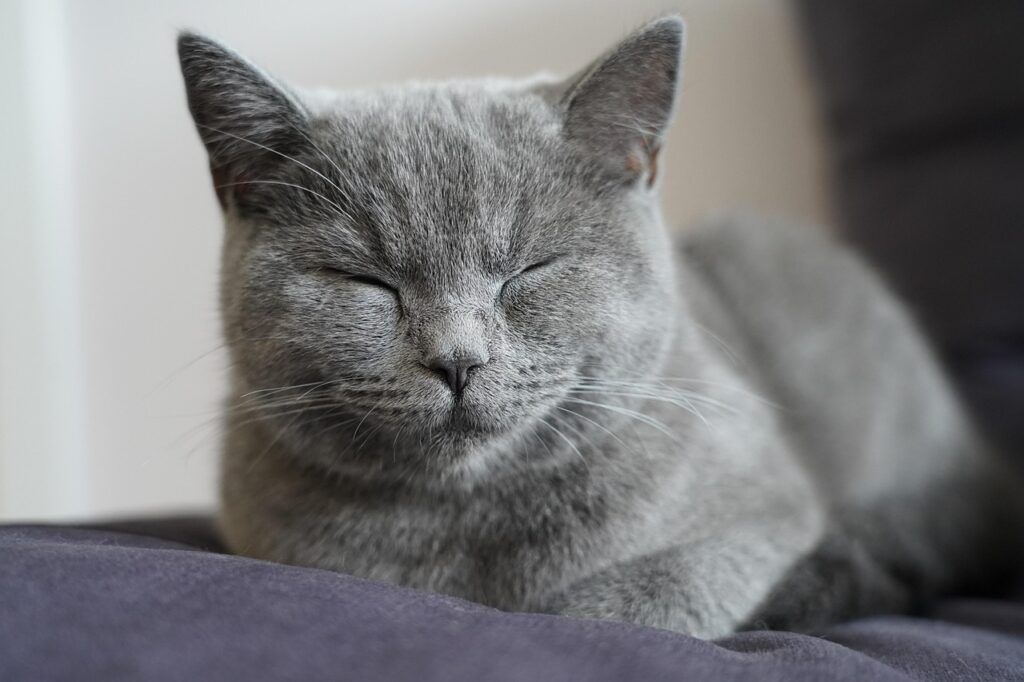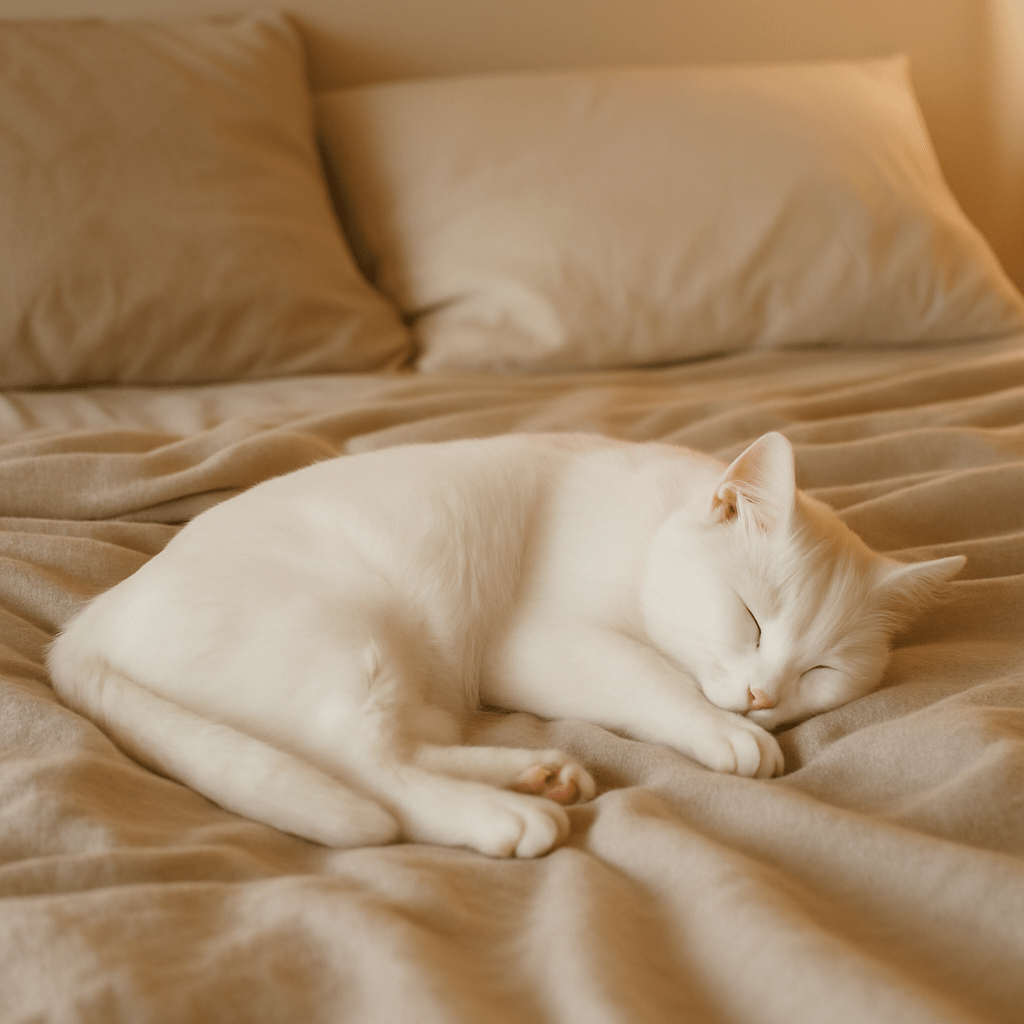Why Does My Cat Sleep on My Bed?

If you’ve a cat, then you’re not alone. You’ve probably woken up to a little roommate curled up at your feet or even right on your pillow. But why does your cat insist on sleeping on your bed instead of their cozy cat bed?
why your cat choose to sleep on your bed rather than their comfy cat bed? Turns out, there are some fascinating (and adorable) reasons behind this behavior.
Your Cat Feels Safe/Secure With You
Cats are naturally cautious animals. Sleeping next to you means they trust you, and it’s a sign that they feel completely secure. In the wild, cats choose safe, quiet places to rest and your bed offers warmth, comfort, and, most importantly, you, their trusted human.
It’s All About Warmth and Comfort
Cats are experts at finding the coziest spots. Cats love warm spots, and your bed is probably the coziest place in the house. Your bed is super comfy, warm, and smells like you (which they love). Plus, your body heat makes it even more inviting, especially during colder months.

They’re Showing Affection
Sleeping on your bed is their way of saying, “You’re my favourite person.” It’s a sign of trust that strengthens your connection and builds emotional trust.
❤️ Fun fact: Cats may purr while sleeping next to you, which is a sign they’re content and happy.
It’s Part of Their Routine
Cats are creatures of habit. Once they’ve claimed your bed as their own, it becomes part of their nightly routine. You might notice your cat coming to bed around the same time every night—almost like they’re tucking themselves in beside you.
Your Bed Is Prime Territory
Cats are territorial animals. If your cat sleeps on your bed, they may be marking it as part of their territory (and you as part of their family). They do this by rubbing their scent onto your sheets, pillow, or even your head!
When your cat sleeps on your bed, it’s more than just a quirky habit—it’s a sign of love, trust, and deep companionship. So next time you wake up with a paw on your face or a tail in your blanket, remember: it’s your cat’s way of saying, “I feel safe with you.”

Like humans, cats can experience various emotions, including anger and frustration.
Common Signs of an Angry Cat
- Flattened Ears: An angry or defensive cat will pin its ears back to protect them.
- Puffed-up Fur: When a cat’s fur stands on end, especially along the back and tail, it’s a sign of heightened aggression or fear.
- Narrowed Eyes: Cats will narrow their eyes or give a piercing glare when they’re upset or feeling defensive.
- Tail Movements: A rapidly flicking or thrashing tail is a sure sign of agitation. A puffed-up tail is an even stronger sign.
- Hissing or Growling: These vocalizations are clear warnings that a cat is not happy and may lash out.
- Claw Extension and Stance: Angry cats will often crouch low, claws extended, ready to either defend themselves or attack.
Common Triggers
- Territorial Issues: Cats are highly territorial creatures, so the introduction of new animals or changes in their environment can upset them.
- Overstimulation: Sometimes, what starts as play or petting can overstimulate a cat, leading to sudden anger or aggression.
- Frustration: If a cat feels it cannot access something (e.g., a bird outside the window), it may become frustrated and agitated.
- Fear or Pain: A scared or injured cat may lash out aggressively to protect itself.
How to Calm an Angry Cat
- Give them space: When cats are angry, they need space to calm down. Avoid trying to pet or engage with them immediately.
- Observe their body language: Pay attention to the warning signs so you can step back before their anger escalates.
- Use calming techniques: Soft voices, gentle blinking, and providing a safe space away from the source of stress can help.
- Identify triggers: Recognizing what sets your cat off is crucial to preventing future anger episodes.
Respecting their boundaries and understanding these signals can lead to a more harmonious relationship.
"Are Cats Possessive of Their Owners? Understanding Feline Attachment"

Do Cats Feel Possessive Over Their Owners?
Cats can form strong bonds with their owners, but their version of attachment differs from that of dogs or other pets. While cats are not possessive in the traditional sense, they do develop a sense of security and comfort from their humans. When cats show behaviors that seem possessive—like demanding attention, getting in the way of other pets, or even following you from room to room—it’s often their way of reinforcing their bond with you and ensuring their place in your life.
Common Signs of Possessive Behavior in Cats
Following you around: Cats that are attached to their owners often want to be near them at all times. If your cat follows you from room to room, it may be showing a form of possessiveness.
Jealousy over other pets or people: Some cats dislike sharing their owners’ attention. They may push other animals away or even act out when you’re interacting with someone else.
Territorial marking: Cats are naturally territorial animals, and they may rub against you or mark areas of the house to claim ownership, not just of their territory, but also of you.
Demanding attention: Cats may meow, paw at you, or even sit on your lap unexpectedly to grab your attention. This behavior can be a sign that your cat sees you as “theirs” and wants to make sure you’re paying attention to them.
Is Possessive Behavior a Problem?
- When It’s Normal: Possessive behavior can be a normal part of a cat’s personality and doesn’t necessarily indicate a problem.
- When to Be Concerned: If possessive behavior leads to aggression, stress, or interferes with your ability to interact with others, it may be an issue to address.
- Managing Possessive Behavior: Tips on ensuring your cat feels secure, such as providing plenty of attention, creating a safe space, and establishing routines.